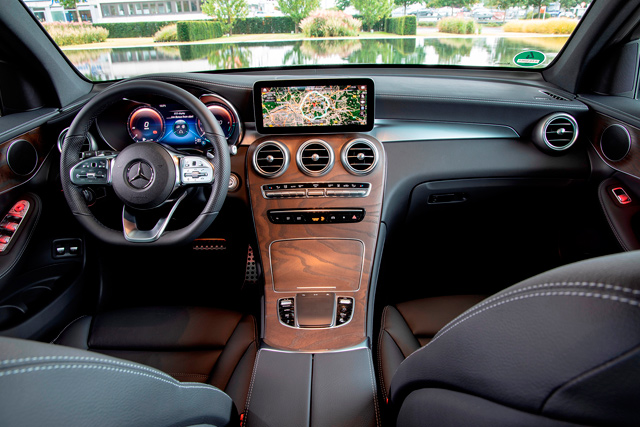Successor to the Mercedes-Benz GLK-Class and similarly based on the C-Class of its era, the mid-size GLC-Class SUV was first launched in 2015, and updated last year. With mild exterior and interior styling updates and a host of expanded and updated technology and assistance systems, the revised GLC-Class models also included drive-line revisions with the addition of 48V mild hybrid technology and an improved full hybrid model, as featured here.
Designated the GLC300e 4Matic, the improved hybrid model gains improved electric output, a new gearbox, quicker acceleration and improved EV range.
A smooth, flowing and elegantly modern compact to mid-size premium SUV with a short front overhang and rearwards cabin design, reflecting its front-engine, rear-drive based architecture, the GLC-Class features smoother edges and surfacing than its GLK-Class predecessor, as well as a higher waistline and rakishly descending roofline. Little altered for 2019, the face-lifted GLC-Class features smaller, more vertical front side intakes, a more aggressive, and heavily chromed lower intake, along with subtle grille and light elements. At the rear, it also receives altered, squared internal light elements, more prominent chrome treatment and discreetly re-styled exhaust ports.
Swift and silence
With little but small badges to distinguish the hybrid model among the line-up, the GLC300e is powered by a combination of an in-line turbocharged, direct injection 2-litre four-cylinder engine developing 208BHP at 5,500rpm and 258lb/ft at 1,200-4,000rpm, and a transmission-integral electric motor producing 120BHP and 324/b/ft. Operating on combustion or electric power or a combination of the two, the GLC300e’s accumulated available system output of 315BHP and 515lb/ft effortlessly and briskly carries its hefty 2,030kg through 0-100km/h 0.2-seconds faster than its predecessor, at just 5.7-seconds and onto a 230km/h top speed.
Driving all four wheels through a 9-speed automatic gearbox replacing the pre-facelift model’s 7-speed unit, the GLC300e better utilises its output for improved performance, versatility and fuel economy, which is rated 2.2-2.6l/100km, combined. With a 13.5kWh battery, the GLC300e boasts improved 39-49km EV range in near silence, suitable for short commutes. More aggressive and faster driving on inclines naturally depletes the battery sooner. Meanwhile, regenerative brakes scavenge and convert some kinetic energy for on the move charging, but as a plug-in hybrid, full charging takes 5-hours on a household socket or 1.5-hours on a more powerful public charger.
Torque and traction
Responsive from standstill with its near instant electric shove and four-wheel-drive traction, the GLC300e is silent and confident in EV mode with plenty of ever-present torque. Abundant and muscular with both motors in operation, it, however, remains a good performer even when its batteries are depleted and it is running mainly on its capable and familiar combustion engine. Significantly heavier than non-hybrid GLC-Class variants, the GLC300e’s performance isn’t noticeably blunted by the additional weight when running on its combustion engine, and is flexible throughout its generous mid-range, and smooth and willing to its redline.
Balanced in its weight distribution and a well-handling vehicle for its weight and height, the GLC300e’s direct and quick steering benefits from the slimmer, less extravagant 235/60R18 tyre option fitted, which serves up better accuracy and feedback through winding roads, not to mention a more compliant ride than optional low profile AMG Line tyre and wheel options. Eager into corners and with good front grip when driven in petrol mode, the GLC300e has an instinct for slight under-steer when pushed hard into and out of corners with both motors unleashing massive, sudden surging torque.
Smooth and spacious
Driven just short of its full power capacity and with more measured inputs, the GLC300e is brisk and eager through switchbacks, with balanced weighting and relatively good lean control. Rear-biased four-wheel-drive provides both decent agility and grip, helps distribute power to be better utilised, and well minimises and quickly catches under-steer, when one flings the GLC300e through tight corners. Capable of 130km/h in EV mode, the GLC300e is stable, reassuring and settled at speed. Comfortable and forgiving over most textures with 18-inch wheels, the GLC300e could do with slightly stiffer front damping over certain speed bumps.
Pleasantly upmarket inside with contemporary classy design and quality, the GLC-Class’ cabin delivers good a good driving position, adjustability, visibility, parking manoeuvrability and space for front and rear passengers. Practical and user-friendly for the most part, the GLC300e’s boot volume is reduced from minimum/maximum 550-/1,600-litres to 395-/1,445-litres owing to hybrid components, while an optional boot floor strap-down — rather than under-floor — spare tyre, further reduces volume. Thoroughly well-equipped with standard and optional infotainment, convenience, safety and driver-assistance systems, the driven model featured reversing camera, parking assistance, blindspot warning and active brake assistance, among much more.
TECHNICAL SPECIFICATIONS
Engine: 2-litre, turbocharged, in-line 4-cylinders/electric motor
Valve-train: 16-valve, DOHC, direct injection
Gearbox: 9-speed automatic, four-wheel-drive
0-100km/h: 5.7-seconds
Maximum speed combined (electric only): 230km/h (130km/h)
Power, BHP (PS) [kW]: 208 (211) [155] @5,500rpm
Electric power, BHP (PS) [kW]: 120 (122) [90]
Combined system power, BHP (PS) [kW]: 315 (320) [235]
Power-to-weight, combined: 155BHP/tonne
Torque, lb/ft (Nm): 258 (350) @ 1,200-4,000rpm
Electric torque, lb/ft (Nm): 324 (440)
Combined system torque, lb/ft (Nm): 516 (700)
Torque-to-weight, combined: 344.8Nm/tonne
Fuel consumption, combined: 2.2-2.6 litres/100km
CO2 emissions, combined: 50-60g/km
Fuel tank: 57-litres
EV range: 39-49km
Battery capacity, kWh: 13.5
Electrical consumption, combined: 16.5-17.8kWh/100km
10-100 per cent charging time, home socket 2.3kW/fast charger 7.4kW: 5-/1.5-hours
Length: 4,658mm
Width: 1,890mm
Height: 1,664mm
Wheelbase: 2,873mm
Track, F/R: 1,621/1,617mm
Overhang, F/R: 830/955mm
Aerodynamic drag co-efficiency: 0.34
Headroom, F/R: 1,064/1,005mm
Shoulder room, F/R: 1,455/1,436mm
Boot capacity, min/max: 395-/1,445-litres
Unladen weight: 2.030kg
Gross weight: 2,615kg
Payload: 585kg
Towing weight, braked/unbraked: 2,000/750kg
Steering: Electric-assisted, rack and pinion
Turning circle: 11.8-metres
Suspension: Multi-link, anti-roll bars
Brakes: Perforated, ventilated/ventilated discs, regenerative braking
Tyres: 235/60R18
